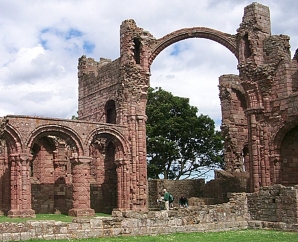| By Hannah R. Bollinger, Evan M. Crowder, Deirdre E. Purdy, and Ryan J. Quinlan
| The sack of the Lindisfarne priory on the 8th of June, 793 marked the dawn of the radical political, social and religious changes that befell Atlantic Europe until the decline of the northern kingdoms in the latter half of the eleventh century, the end of the “Viking Age.” Located on an isolated island off of the coast of Northumbria in modern north-east England, Lindisfarne served as one of early England’s most revered monasteries, housing the relics of St. Cuthbert, one of the priory’s former bishops and the Lindisfarne Gospels, an illuminated text containing the gospels of Matthew, Mark, Luke and John in both Latin and Old English. |

|
Established in 635, the monastery was a center of education, religion and thought until late in the eighth century (Cavill, 169). What were, however, the motives for raiding Lindisfarne that June? There are many factors, including the religious structure of medieval England, Viking maritime technology, geography and the increasing pressure to colonize in order to relieve the strain on resources brought about by Norse overpopulation.
Play an Interactive Fiction Game which takes you to Lindisfarne
TEST YOUR KNOWLEDGE OF THIS SITE
Read more about Lindisfarne and Medieval Monastic Medicine by Hannah R. Bollinger
Read more about the Raid at Lindisfarne Priory and the End of the Northumbrian Renaissance by Evan M. Crowder
Read more about the raid on Lindisfarne Priory as an insight into Viking Age Britain by Deirdre E. Purdy
Read more about the Sack of Lindisfarne Priory and the Dawn of the Viking Age by Ryan J. Quinlan
Bollinger Bibliography
Crowder Bibliography
Purdy Bibliography
Quinlan Bibliography
|

View Text

View Images

View Panoramas
|


